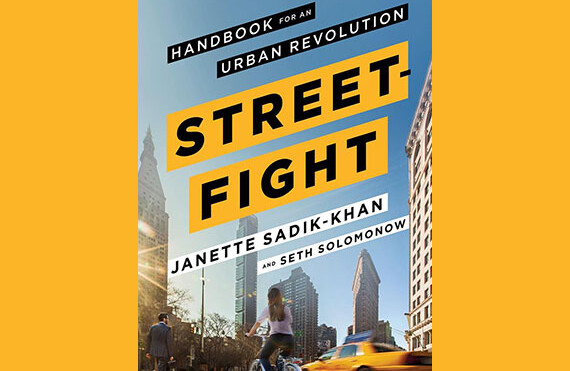Janette Sadik-Khan was New York City's transportation commissioner from 2007-2013. Under her watch, the city's streets were reimagined and redesigned to include more than 60 plazas and 400 miles of bike lanes—radical changes designed to improve traffic and make spaces safer for everybody. Over seven years, New York City underwent a transportation transformation, played out avenue by avenue, block by block. Times Square went from being the city's worst traffic nightmare to a two-and-a-half acre outdoor sitting area in 2009. Citi Bike, arguably her biggest success, is the nation's largest bike share system, and the city's first new transit system in over half a century. In Streetfight, Sadik-Khan breaks down her achievements into replicable ideas for urban planners and traffic engineers everywhere, and she also reminds us that the fight isn't over. As part of Bloomberg Associates, she now takes the lessons from New York City's streets to metropolises around the world.
The old order vs the new order
The crux of the problem, she explains, is that until recently, cities of the future were thought to be cities built for cars, not cities that encouraged human activity on the street.
Understanding what city-building used to mean is key to understanding how our cities are failing us today. Sadik-Khan offers a quick recap of New York City through recent decades. The historical lesson holds; in many ways, cities in every continent grew along a similar trajectory. Streets were designed to keep traffic moving, but not to support the life alongside it. The old order—which Sadik-Khan writes is typified by Robert Moses—took the auto-centric view that pedestrians, public transit, and bike riders were all hindrances in the path of cars.
Sadik-Khan calls for a more equitable and relevant city, one that prioritizes accessibility and convenience for everybody. Her generation of planners aims to transform roads, tunnels, and rail tracks—the legacy hardware of their predecessors—and repurpose them into public spaces to walk, bike, and play.
The strength of the book lies in just how effectively it dispels the misconceptions that most citizens, and indeed, urban planners, have held onto for decades. There are plenty of surprises in Streetfight.
Sadik-Khan shows that people's ideas about safety can be obsolete. For instance, bike lanes don't make accidents more likely, they make the streets safer. The statistics show that bike riders actually protect pedestrians by altering the behavior of drivers. Sadik-Khan states that bike ridership in New York City quadrupled from 2000-2012; and as the number of riders increases, so too does the safety of the street.
The assumption, for instance, that reducing lanes or closing them entirely creates gridlock, is entirely wrong. Sadik-Khan's interventions in New York City —providing pedestrian space and creating fewer but more orderly lanes for vehicles—actually improved traffic. And she uses taxi GPS data to prove it.
The idea that culling parking spaces is a death knell for local businesses is also false. It turns out that limiting private vehicles and expanding access to those arriving by public transportation, foot or bike, is better for the economics of a neighborhood. Soon after Times Square was redesigned into a pedestrian plaza, it was listed as one of the top 10 most valuable retail locations in the world. And on First Avenue, by 2011, after the introduction of bike and bus lanes, commercial vacancies fell by 47 percent.
In fact, Sadik-Khan makes the claim that the economic power of sustainable streets is probably one of the strongest arguments for implementing dramatic change. Cities need data—think retail rents, shop sales, travel speeds, vehicle counts—to defend their interventions, and then to measure their effectiveness. Yet, she writes, unfortunately there are few cities anywhere that have access to reliable numbers of this kind.
You get what you build for
Sadik-Khan observes that there are hundreds of cities around the world currently debating whether public transit is worth the investment, while attempting to build their way out of congestion. But, in the words of Lewis Mumford, 20th century architectural critic, "trying to address congestion by building more traffic lanes is like trying to prevent obesity by loosening one's belt."
For too long, transportation planners have ignored this very basic tenet, she writes, that you get what you build for. If you widen roads, you get more traffic. The streets just become more congested, and more dangerous. There are enough studies to prove this, and Sadik-Khan preempts skepticism by citing a few. Her point is this: If cities need more people to take buses and trains or to bike and walk, then they must invest in trains, buses, bikes, and better streets.
Too often, though, residents of a city think their city leaders and urban planners are hobbled by bureaucracy and shoestring budgets, if not a complete lack of foresight. The prevailing notion is that the cities we have are the cities we are stuck with. Sadik-Khan upends that idea. She stresses the need for "private-sector metabolism," for innovative approaches to problems that cut through red tape. And she shows that this is eminently possible.
For those who find these street innovations hard to visualize, Streetfight includes diagrams to illustrate them. Step by step, adding protected bike paths, curb extensions, and bus lanes, Sadik-Khan shows how a street's "source code" can be redesigned in countless ways if planners stop being limited by the old ways of thinking. These diagrams, along with plenty of photographs documenting the transformations she engineered across the five boroughs, really help people see that solutions that seemed impossible can actually just be very smart, and very simple.
While New Yorkers were "80 years into their wait for the Second Avenue Subway," Sadik-Khan worked with the MTA to develop New York's popular Select Bus Service network. In seven years' time, there were SBS routes in all five boroughs—each bus taking the equivalent of 50 cars off the road, and at around 5 percent of the cost of a new metro system. In Sadik-Khan's view, bus rapid transit systems will be increasingly important to cities for the future, especially poorer ones. She adds that buses don't have to be slow or unreliable; it is the design of the street that fails them.
Sadik-Khan emphasizes time and again that change can happen quickly and affordably. She didn't have to bulldoze neighborhoods, or build new bridges and highways to transform the transportation network of New York City. Planners can reorder a street without destroying a single building.
Streetfight is a handbook that prioritizes paint, planters, signs, and signals over mega-infrastructure projects. We are told that small-scale interventions can have transformative large-scale impacts. Sadik-Khan's pocket parks, plazas, pedestrian-friendly road redesigns, and parking-protected bike lanes are all the proof we need. For planners in developing countries, this should serve as both guide and encouragement.
Innovation doesn't need big dollars behind it to be effective, and most ideas are scalable for cities big and small. What it does need, however, is street smarts. Sadik-Khan makes it clear that the key to getting projects to move ahead is support on the ground, and enough political capital to pave the way. Planners everywhere need to encourage participation, invite ideas, and be more transparent about proposals, she writes. But they also need to be willing to put up a fight.
In Sadik-Khan's view, "changing the streets is a blood sport at all levels." While it's important for planners to look at the way that people most prefer to use their streets, it's equally necessary not to be shackled by those same people. Too often, city officials are stuck endlessly waiting to implement interventions because they seek to avoid disagreement with city residents who resist change. In her experience, people cling to stability even if it is inefficient—decades past, highway megaprojects resulted in picketing and protests; just a few years ago, many residents of New York City reacted much the same way at the prospect of a bike lane.
Sometimes, transformations just need to be tried out. Interventions can often be the catalyst for their own approval. Sadik-Khan recounts how, minutes after setting out barrels to divert traffic and start work on the plaza at Madison Square, a group of art students sat down on the blacktop and started to sketch. It can take no time at all for people to accept public space and make it their own.
Sadik-Khan calls for residents to start thinking about the possibilities of their city in vastly different ways—not just to hope for reduced congestion and fewer potholes, but to embrace actual change. Streetfight is a manifesto for new ideas, and often counter-intuitive ones. In her view, we can't wait for infrastructure to crumble before taking action. Cities need to be more equitable and sustainable as they grow and move towards the future. Inaction, she writes, is inexcusable.
Sustainability matters
Cities today are the most efficient places to live in the world. The numbers are compelling: New Yorkers have a carbon footprint 71 percent lower than that of the average American. Planners reimagining cities for the future must also build sustainability into their plans so that cities can continue to be efficient as they grow.
Sadik-Khan reiterates that long-term sustainability plans must reach across departments and consider issues of land use, energy, waste management, and air quality. She offers several examples from her tenure: the Department of Transportation's (DOT) use of recycled asphalt, its move to convert all of New York City's streetlights to LEDs by 2017, its research into bioswales and permeable payments to capture rainwater and prevent runoff into the harbor.
But although cities around the world are more efficient than their suburban counterparts, they are also becoming increasingly more vulnerable. A two-foot rise in sea level along the East Coast, for instance, could submerge 600 miles of rail, dozens of ports, and all three New York City airports, writes Sadik-Khan. Planners everywhere need to realize the fragility of existing transportation infrastructure and start thinking about how to build climate resilience into the design of their cities.
Sadik-Khan's interventions as transportation commissioner deconstructed, reassembled, and reinvented the street. Streetfight is certainly path-breaking for city residents who've long thought that people-focused streets are an impossibility. But more importantly, it's a handbook for the city officials and planners who can make those streets a reality. There are no lofty, abstract idealisms here, only models for a new road order that have been tried and tested. If you need to know how many seconds for a green light, or how many feet to the curb make a difference, Sadik-Khan will tell you.
Her fight for New York City's streets holds lessons for cities everywhere. The future of cities depends on that fight being fought well, and won. After all, cities that invest in sustainable streets will get what they paid for. And it's what they need to survive.




